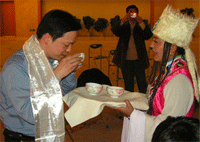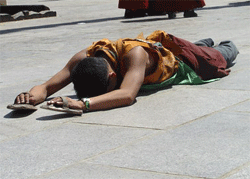|
Tibetan's Etiquette
Present
Hada
Hada is a piece of silk used as a greeting
gift among the Tibetan nationalities. Present
hada is a common practice among the Tibetan
people to express their best wishes on many
occasions, such as  wedding
ceremonies, festivals, visiting the elders
and the betters, and entertaining guests.
Tibetan like white, they regard white as pure,
lucky and rich. wedding
ceremonies, festivals, visiting the elders
and the betters, and entertaining guests.
Tibetan like white, they regard white as pure,
lucky and rich.
There are also other colors besides white.
Blue, yellow and multicolored hada are also
made. Multicolored Hada is presented to Buddhist.
This hada is the dress of Buddist. The color
of it is blue, white,red, green and yellow,
and they respectively stand for sky, cloud,
river, the guardian of Buddhism and earth.
Bow
In the past, when a Huarui Tibetan meets the
senior, he should take off the hat and bow
down with 45 degree. The hat is in hands and
nearly low to ground. For common people, bow
only shows manners, the hat is put down to
front of chest and the head lowers only a
little.
Some bow with matching the palm. If one bows
to the senior, the palms should be higher
than the top of the head. When return to a
salute, the act is the same.
Kotow
Kotow is common etiquette among Tibetans.
Tibetans will kotow to Buddhist image, chorten
or a Living Buddha. Sometimes people will
also kotow to a senior.
 Kotow
can be classified to three types, Long Kotow,
Short Kotow and Sound Kotow. Kotow
can be classified to three types, Long Kotow,
Short Kotow and Sound Kotow.
Long Kotow is with two hands raising high
above the head, and from the top of head to
forehead and chest to bow three times, at
last grovel on the ground with hands stretching
straightly. Then repeat the action.
Short Kotow is with two hands matching in
front of the chest and knee down to bow. People
would generally bow for three times.
In temples, people will also make Sound Kotow
- with two hands matching in front of the
chest, bow down to the feet of Buddhist statue,
and the head touching the feet. This shows
people's confess to Buddhist.
|